【持续性肾脏替代治疗CRRT英文精品课件】肾脏替代治疗病人的管理
合集下载
【持续性肾脏替代治疗CRRT英文ppt课件】NierenersatztherapieimKindesalter

Mögliche Diagnosen für ANV bei Sgl.
• autosomal recessive polycystic kidney disease (ARPKD),
• obstruktive Uropathie mit Nierendysplasie, • Posteriore Urethralklappe • kongenitales nephrotisches Syndrom • Kortikale Nekrose
代理报关委托书委托报关协议关于审 理城镇 房屋租 赁合同 纠纷案 件司法 解释有 关劳务 派遣制 度设计 及对劳 务派遣 行业的 影响分 析糖皮 质激素 在呼吸 系统疾 病中的 合理应 用严重 脓毒症 导致急 性肺损 伤病人 自发利 尿现象 的观察 分析
Arten der Nierenersatztherapie
Hämodialyse
Peritonealdialyse
intermittierend
kontinuierlich
代理报关委托书委托报关协议关于审 理城镇 房屋租 赁合同 纠纷案 件司法 解释有 关劳务 派遣制 度设计 及对劳 务派遣 行业的 影响分 析糖皮 质激素 在呼吸 系统疾 病中的 合理应 用严重 脓毒症 导致急 性肺损 伤病人 自发利 尿现象 的观察 分析
Peritonealdialyse oder Hämodialyse?
• Beide Methoden sind notwendig: • wenn möglich, ist die CAPD bei Säuglingen
besser, aber bei Komplikationen der CAPD ist ein Ersatz in Form der HD für das Überleben essentiell.
• autosomal recessive polycystic kidney disease (ARPKD),
• obstruktive Uropathie mit Nierendysplasie, • Posteriore Urethralklappe • kongenitales nephrotisches Syndrom • Kortikale Nekrose
代理报关委托书委托报关协议关于审 理城镇 房屋租 赁合同 纠纷案 件司法 解释有 关劳务 派遣制 度设计 及对劳 务派遣 行业的 影响分 析糖皮 质激素 在呼吸 系统疾 病中的 合理应 用严重 脓毒症 导致急 性肺损 伤病人 自发利 尿现象 的观察 分析
Arten der Nierenersatztherapie
Hämodialyse
Peritonealdialyse
intermittierend
kontinuierlich
代理报关委托书委托报关协议关于审 理城镇 房屋租 赁合同 纠纷案 件司法 解释有 关劳务 派遣制 度设计 及对劳 务派遣 行业的 影响分 析糖皮 质激素 在呼吸 系统疾 病中的 合理应 用严重 脓毒症 导致急 性肺损 伤病人 自发利 尿现象 的观察 分析
Peritonealdialyse oder Hämodialyse?
• Beide Methoden sind notwendig: • wenn möglich, ist die CAPD bei Säuglingen
besser, aber bei Komplikationen der CAPD ist ein Ersatz in Form der HD für das Überleben essentiell.
【持续性肾脏替代治疗CRRT英文精品课件】Renal Failure Acute and Chronic

Intrarenal
Nephrotoxic agents, infections, ischemia and blockages, polycystic kidney disease
Postrenal
Stones, blood clots, BPH, urethral edema from invasive procedures
Skin
Yellow-bronze skin with pallor Puritus Purpura Uremic frost Thin, brittle nails Dry, brittle hair, and may have color changes and alopecia
Chronic Renal Failure
Chronic Renal Failure
Objective symptoms
Endocrine
Stunted growth in children Amenorrhea Male impotence ^ aldosterone secretion Impaired glucose levels R/T impaired CHO metabolism Thyroid and parathyroid abnormalities
Dialysis is necessary D/T accumulation or uremic toxins, which produce changes in major organs
Chronic Renal Failure
Subjective symptoms are relatively same as acute
Chronic Renal Failure
Nephrotoxic agents, infections, ischemia and blockages, polycystic kidney disease
Postrenal
Stones, blood clots, BPH, urethral edema from invasive procedures
Skin
Yellow-bronze skin with pallor Puritus Purpura Uremic frost Thin, brittle nails Dry, brittle hair, and may have color changes and alopecia
Chronic Renal Failure
Chronic Renal Failure
Objective symptoms
Endocrine
Stunted growth in children Amenorrhea Male impotence ^ aldosterone secretion Impaired glucose levels R/T impaired CHO metabolism Thyroid and parathyroid abnormalities
Dialysis is necessary D/T accumulation or uremic toxins, which produce changes in major organs
Chronic Renal Failure
Subjective symptoms are relatively same as acute
Chronic Renal Failure
【持续性肾脏替代治疗CRRT英文课件】CRRT

CRRT can also be used for patients with severe sepsis or septic shock who need fluid resuscitation and unstable hemodynamics. Through CRRT, these patients can be effectively resuscitated and their vital signs can be stabilized.
03
Acute renal failure (ARF) is a sudden loss of kidney function that requires urgent medical intervention. CRRT can be used to remove toxins, adjust electrolyte balance, and control fluid overload in patients with ARF. It provides continuous clearance of urea, creatinine, and other waste products from the blood, helping to maintain normal生理功能 and prevent further damage to the kidneys.
Liver failure is a condition in which the liver is unable to perform its essential functions, such as detoxification, protein synthesis, and bile production. It can lead to a buildup of toxins in the blood and other serious complications. CRRT can be used to remove these toxins, helping to stabilize the patient's condition.
【持续性肾脏替代治疗CRRT英文精品课件】 Le nuove competenze del Cardiologo_

• Il cardiologo deve familiarizzare con alcuni parametri di monitoraggio tra i quali può essere utile la distanza setto-device (se > 10 mm è indice di buon riempimento del Vsx, se < 10 mm è indice di eccessivo svuotamento e può determinare il cosiddetto “suckdown effect”)
ECMO
(ExtraCorporeal Membrane Oxygenation)
Thoratec VAD - Medos Berlin Heart
Impiantabili Impiantabili
non
pulsatili
pulsatili
Jarvik 2000
Novacor System HeartMate TCI
HeartMate II
Jarvik 2000 Heart
Pompa assiale tot. impiantabile 8000 – 12000 rpm Flusso continuo (max 8 l/min) Diametro: 2,5 cm, lunghezza: 5,5 cm Peso 85 g Impercettibile dal paziente
JARVIK 2000
• Tra gli aspetti gestionali è utile sapere che la misurazione non invasiva della PA nei livelli di assistenza più alti deve essere effettuata negli 8 sec in cui la velocità di rotazione della microturbina si riduce automaticamente permettendo l’apertura della valvola aortica nativa, e quindi gonfiando il manicotto subito prima della riduzione automatica della velocità o riducendo il livello di assistenza al livello più basso (mettendo in tal caso il paziente in posizione supina);
ECMO
(ExtraCorporeal Membrane Oxygenation)
Thoratec VAD - Medos Berlin Heart
Impiantabili Impiantabili
non
pulsatili
pulsatili
Jarvik 2000
Novacor System HeartMate TCI
HeartMate II
Jarvik 2000 Heart
Pompa assiale tot. impiantabile 8000 – 12000 rpm Flusso continuo (max 8 l/min) Diametro: 2,5 cm, lunghezza: 5,5 cm Peso 85 g Impercettibile dal paziente
JARVIK 2000
• Tra gli aspetti gestionali è utile sapere che la misurazione non invasiva della PA nei livelli di assistenza più alti deve essere effettuata negli 8 sec in cui la velocità di rotazione della microturbina si riduce automaticamente permettendo l’apertura della valvola aortica nativa, e quindi gonfiando il manicotto subito prima della riduzione automatica della velocità o riducendo il livello di assistenza al livello più basso (mettendo in tal caso il paziente in posizione supina);
【持续性肾脏替代治疗CRRT英文精品课件】aspetti clinici della crrt. indicazione, timing, anticoagulazi

CRRT - SMART 2008
CRRT - SMART 2008
CRRT - SMART 2008
CRRT - SMART 2008
meropenem
CRRT - SMART 2008
imipenem
CRRT - SMART 2008
carbapenemici
CRRT - SMART 2008
Protein binding and CRRT
CRRT - SMART 2008
Protein binding , CRRT and supplemental dosing
CRRT - SMART 2008
CRRT - SMART 2008
CRRT - SMART 2008
CRRT - SMART 2008
CRRT - SMART 2008
CRRT - SMART 2008
CRRT - SMART 2008
Milano
CRRT - SMART 2008
CRRT - SMART 2008
CRRT - SMART 2008
CRRT - SMART 2008
CRRT - SMART 2008
CRRT - SMART 2008
Criteria for Initiation of RRT
The “RIFLE - SCORE” Approach
CRRT - SMART 2008
CRRT - SMART 2008
• Heparin anticoagulation is the most commonly used method to prevent clotting in CRRT
• Often the sole anticoagulant in continuous venovenous hemofiltration
【持续性肾脏替代治疗CRRT英文课件】ASPNMEMBERSHIPSURVEY

Stable hemodynamics
CRRT is less likely to cause hemodynamic instability compared to intermittent dialysis methods, as it provides a more gradual and controlled exchange of toxins and fluids.
Continuous renal replacement
therapy (CRRT) Englis
目录
• Introduction to Continuous Renal Replacement Therapy (CRRT)
• The application of CRRT in clinical practice
CRRT was first developed in the 1970s as a 01 treatment for acute kidney injury in critically
ill patients.
Over the years, CRRT technology has evolved 02 and improved, making it a more effective
and safer treatment option.
Currently, CRRT is widely used in ICUs and 03 nephrology wards worldwide to manage
acute kidney injury in critically ill patients.
• The advantages and disadvantages of CRRT
CRRT is less likely to cause hemodynamic instability compared to intermittent dialysis methods, as it provides a more gradual and controlled exchange of toxins and fluids.
Continuous renal replacement
therapy (CRRT) Englis
目录
• Introduction to Continuous Renal Replacement Therapy (CRRT)
• The application of CRRT in clinical practice
CRRT was first developed in the 1970s as a 01 treatment for acute kidney injury in critically
ill patients.
Over the years, CRRT technology has evolved 02 and improved, making it a more effective
and safer treatment option.
Currently, CRRT is widely used in ICUs and 03 nephrology wards worldwide to manage
acute kidney injury in critically ill patients.
• The advantages and disadvantages of CRRT
【持续性肾脏替代治疗CRRT英文课件】DialysisintheCritically

Heparin free treatment
For patients with contraindications to heparin use, heparin free treatment can be used to prevent thrombosis by continuously flushing filters and extracorporeal circulation pipelines.
Select appropriate replacement fluid according to the patient's condition and needs, such as lactate Ringer's solution, acetic acid Ringer's solution, etc.
Type of replacement fluid
Heat the replacement fluid to an appropriate temperature to avoid adverse effects on patients due to low or high temperatures.
Heparin
Low molecular weight heparin or ordinary heparin is used for anticoagulation treatment to prevent the formation of blood clots during cardiopulmonary bypass.
CRRT is often used in patients who are in shock, have severe acute kidney injury, or are unable to maintain fluid balance through natural mechanisms
For patients with contraindications to heparin use, heparin free treatment can be used to prevent thrombosis by continuously flushing filters and extracorporeal circulation pipelines.
Select appropriate replacement fluid according to the patient's condition and needs, such as lactate Ringer's solution, acetic acid Ringer's solution, etc.
Type of replacement fluid
Heat the replacement fluid to an appropriate temperature to avoid adverse effects on patients due to low or high temperatures.
Heparin
Low molecular weight heparin or ordinary heparin is used for anticoagulation treatment to prevent the formation of blood clots during cardiopulmonary bypass.
CRRT is often used in patients who are in shock, have severe acute kidney injury, or are unable to maintain fluid balance through natural mechanisms
【持续性肾脏替代治疗CRRT英文ppt课件】ARF

ARF in ICU
• ARF is common in the ICU • ARF is an independent factor for prognosis
in the ICU • The incidence of ARF in the ICU40 – 60%
compared to 1- 3% in the ward • ARF still has a mortality of 50% since it
patients develop non-oliguric ARF eg. After radiocontrast media • Acute-on chronic renal failure
Aetiology of ARF
• Pre-renal • Renal
– Glomerular – Tubulointerstitial – Vascular
• Post-renal
Aetiology of ARF
• Glomerular
– RPGN
• Tubulointerstitial
– Acute tubular necrosis – Acute tubulointerstitial nephritis – Infection – Cast nephropathy
• Loss of intact or necrotic tubular cells
• Occlusion of tubular cells by debris
• The decline in renal function is often more prominent than the severity of histological changes
【持续性肾脏替代治疗CRRT英文课件】AKI

CRRT has the advantages of gentle treatment, less damage to the patient's body, and can be used in critically ill patients who cannot tolerate hemodialysis. It is widely used in the treatment of severe acute kidney injury, sepsis, and other critical illnesses. CRRT is an important treatment method in the field of critical care medicine.
In patients with severe heart failure, CRRT can be used to remove excess fluid from the body and help to reduce the workload on the heart.
CRRT's slow and controlled fluid removal allows for better hemodynamic stability in patients with severe heart failure, reducing the need for emergency interventions.
CRRT can be used as a bridge to transplantation or as a palliative treatment option for patients with severe heart failure.
【持续性肾脏替代治疗CRRT英文ppt课件】When-to-Start-RRT-in-AKI

than late group, leading to suggestion that there was a confounding effect (?physician bias)
More Retrospective Studies
• Elahi et al eported a series of 64 consecutive patients s/ p cardiac surgery at a single UK center between January 2002 and January 2003
• Similar demographics and baseline clinical characteristics
• Surgery to renal support time was 2.6+2.2 days vs 0.8+0.2 days
Limitations of the studies
• Survival - 5/8 pts (64%) vs 2/10 (20%) pts • Major complications (Gram-neg. sepsis,
hemorrhage) were less freq in intensive arm
Increased Mortality in Early HD
• In 28 pts, CVVHDF was started once BUN>84, SCr>2.8, or serum K>6, despite medical therapy and regardless of UOP
• Remaining 36 pts, CVVHDF was initiated when UOP was <100ml over 8 hrs despite Lasix
More Retrospective Studies
• Elahi et al eported a series of 64 consecutive patients s/ p cardiac surgery at a single UK center between January 2002 and January 2003
• Similar demographics and baseline clinical characteristics
• Surgery to renal support time was 2.6+2.2 days vs 0.8+0.2 days
Limitations of the studies
• Survival - 5/8 pts (64%) vs 2/10 (20%) pts • Major complications (Gram-neg. sepsis,
hemorrhage) were less freq in intensive arm
Increased Mortality in Early HD
• In 28 pts, CVVHDF was started once BUN>84, SCr>2.8, or serum K>6, despite medical therapy and regardless of UOP
• Remaining 36 pts, CVVHDF was initiated when UOP was <100ml over 8 hrs despite Lasix
【持续性肾脏替代治疗CRRT英文课件】AccessBrophy

The display solution is typically a crystalline solution, such as activated Ringer's or normal sales It is important to use a solution that is isotropic and does not contain any additives that could react with the blood
Filtration
Waste and extra fluid are filtered out of the blood and replaced with dialysate
Reinfusion
Filtered blood is returned to the patient's circulation
The display solution is a sterile solution that is used to prime the extracorporeal circuit before treatment It is also used to prime the dialyzer and lines during treatment
Patients with severe acute pancreatitis may require strict volume management to prevent heart failure and pulmonary edema. CRRT can accurately control the intake and excretion of fluids, helping to maintain the stability of the circulatory system.
Filtration
Waste and extra fluid are filtered out of the blood and replaced with dialysate
Reinfusion
Filtered blood is returned to the patient's circulation
The display solution is a sterile solution that is used to prime the extracorporeal circuit before treatment It is also used to prime the dialyzer and lines during treatment
Patients with severe acute pancreatitis may require strict volume management to prevent heart failure and pulmonary edema. CRRT can accurately control the intake and excretion of fluids, helping to maintain the stability of the circulatory system.
【持续性肾脏替代治疗CRRT英文课件】FocusonDialysis

Indications: CRRT is mainly used to treat critical diseases such as acute renal failure, multiple organ dysfunction syndrome, sepsis, and severe pancreatitis.
CRRT machine
CRRT machine is a device used for continuous renal replacement therapy, which can continuously and slowly remove toxins and excess water from the body.
History
The development of CRRT began in the 1970s and was initially used to treat acute renal failure. With the continuous improvement of technology, it is now widely used in the treatment of multiple organ dysfunction syndrome.
CRRT mainly focuses on relieving symptoms by clearing toxins and excess water from the blood, while Diagnosis focuses more on identifying the etiology and pathophysiological mechanisms, providing a basis for subsequent treatment.
- 1、下载文档前请自行甄别文档内容的完整性,平台不提供额外的编辑、内容补充、找答案等附加服务。
- 2、"仅部分预览"的文档,不可在线预览部分如存在完整性等问题,可反馈申请退款(可完整预览的文档不适用该条件!)。
- 3、如文档侵犯您的权益,请联系客服反馈,我们会尽快为您处理(人工客服工作时间:9:00-18:30)。
metabolites Diminished osmotic stimulation of thirst Incomplete emptying of bladder Urinary incontinence
Diagnostic Evaluation
Urinalysis and culture
Urine tests
Albuminuria—albumin in urine not measurable by dipstick
Normal values in freshly voided sample should range between 2.0-20 for men and 2.8-28 for women. Higher levels indicate microalbuminuria.
Creatinine clearance—tests clearance of creatinine in one min. Reflects GFR.
Serum creatinine—measures effectiveness of renal function. 0.6 to 1.2 mg/dL
Nur 4206 Management of patients with
renal/urinary disorders
By Linda Self
Functions of the Kidney
Regulation of water excretion Regulation of electrolyte function Regulation of acid-base balance—retain
Can also be determined by 24h specimen
Renal Function tests
Urine osmolality—indication of concentrating ability, changes seen early in disease processes
Excretion of waste products-body’s main excretory organ. Urea, creatinine, phosphates, uric acid and sulfates. Drug metabolites.
Risk factors for renal or urologic disorders
Urea nitrogen—also indicator of renal function. 7-18 mg/dL. Measures renal excretion of urea nitirogen, a byproduct of protein metabolism. Is not always elevated with kidney disease. Not best indicator of renal function.
Gerontologic Considerations
GFR decreases following 40 years with a yearly decline of about 1 mL/min
Renal reserve declines Multiple medications can result in toxic
HCO3- and excrete acid in urine Regulation of blood pressure--RAAS Regulation of RBCs Vitamin D synthesis
Functions of Kidney cont.
Secretion of prostaglandin E and prostacyclin which cause vasodilation, important in maintaining renal blood flow
Renal function tests cont.
Liver must function properly to produce urea nitrogen. BUN levels indicate the extent of renal clearance of this nitrogenous waste product.
Sp. Gravity—1.005-1.020 Microscopic examination for protein, RBCs,
ketones, glycosuria, presence of bacteria, general appearance and odor Leukocyte esterase—enzyme found in WBCs Nitrites –bacteria convert nitrates to nitrites Osmolality—accurate measurement of the kidney’s ability to concentrate urine. Normal rБайду номын сангаасnge is 500-1200 mOsm/kg. Culture important in ‘Id’ing pathogen
1. Hypertension 2. Diabetes mellitus 3. Immobilization 4. Parkinson’s disease 5. SLE 6. Gout 7. Sickle cell anemia, multiple myeloma 8. BPH 9. Pregnancy 10. SCI
May see elevation of BUN with bleeding into tissues or from rapid cell destruction from infection/steroids
Renal Function Tests
Diagnostic Evaluation
Urinalysis and culture
Urine tests
Albuminuria—albumin in urine not measurable by dipstick
Normal values in freshly voided sample should range between 2.0-20 for men and 2.8-28 for women. Higher levels indicate microalbuminuria.
Creatinine clearance—tests clearance of creatinine in one min. Reflects GFR.
Serum creatinine—measures effectiveness of renal function. 0.6 to 1.2 mg/dL
Nur 4206 Management of patients with
renal/urinary disorders
By Linda Self
Functions of the Kidney
Regulation of water excretion Regulation of electrolyte function Regulation of acid-base balance—retain
Can also be determined by 24h specimen
Renal Function tests
Urine osmolality—indication of concentrating ability, changes seen early in disease processes
Excretion of waste products-body’s main excretory organ. Urea, creatinine, phosphates, uric acid and sulfates. Drug metabolites.
Risk factors for renal or urologic disorders
Urea nitrogen—also indicator of renal function. 7-18 mg/dL. Measures renal excretion of urea nitirogen, a byproduct of protein metabolism. Is not always elevated with kidney disease. Not best indicator of renal function.
Gerontologic Considerations
GFR decreases following 40 years with a yearly decline of about 1 mL/min
Renal reserve declines Multiple medications can result in toxic
HCO3- and excrete acid in urine Regulation of blood pressure--RAAS Regulation of RBCs Vitamin D synthesis
Functions of Kidney cont.
Secretion of prostaglandin E and prostacyclin which cause vasodilation, important in maintaining renal blood flow
Renal function tests cont.
Liver must function properly to produce urea nitrogen. BUN levels indicate the extent of renal clearance of this nitrogenous waste product.
Sp. Gravity—1.005-1.020 Microscopic examination for protein, RBCs,
ketones, glycosuria, presence of bacteria, general appearance and odor Leukocyte esterase—enzyme found in WBCs Nitrites –bacteria convert nitrates to nitrites Osmolality—accurate measurement of the kidney’s ability to concentrate urine. Normal rБайду номын сангаасnge is 500-1200 mOsm/kg. Culture important in ‘Id’ing pathogen
1. Hypertension 2. Diabetes mellitus 3. Immobilization 4. Parkinson’s disease 5. SLE 6. Gout 7. Sickle cell anemia, multiple myeloma 8. BPH 9. Pregnancy 10. SCI
May see elevation of BUN with bleeding into tissues or from rapid cell destruction from infection/steroids
Renal Function Tests
